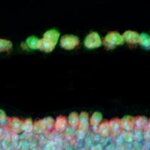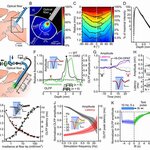Neuroscience

Eric R. Kandel, MD, who shared the 2000 Nobel Prize in Physiology or Medicine for his discoveries related to the molecular basis of memory, and Denise B. Kandel, PhD, professor of psychiatry at Columbia University Medical Center, write in the New England Journal of Medicine that electronic cigarettes (e-cigarettes) may function as a "gateway drug"—a drug that lowers the threshold for addiction to other substances, such as marijuana and cocaine— as part of the 120th Shattuck lecture and presented to the Massachusetts Medical Society.
In the lecture, the Kandels review Denise Kandel's…

There are sex differences in the development of tolerance to THC, the key active ingredient in cannabis, according to a new paper.
Psychology professor Rebecca Craft of Washington State University believes that estrogen levels are why female rats are at least 30 percent more sensitive than males to the pain-relieving qualities of THC and develop tolerance to THC more quickly. These sensitivities could increase vulnerability to negative side effects like anxiety, paranoia and addiction.
Many unknowns
Craft notes that researchers like Margaret Haney at the Columbia…

When we learn, we associate a sensory experience with other stimuli or with a certain type of behavior.
The neurons in the cerebral cortex that transmit the information modify the synaptic connections that they have with the other neurons and according to a generally accepted model of synaptic plasticity, a neuron that communicates with others of the same kind emits an electrical impulse as well as activating its synapses transiently. This electrical pulse, combined with the signal received from other neurons, acts to stimulate the synapses.
How is it that some neurons are caught up in the…

Until the last few decades, the frontal lobes of the brain were shrouded in mystery and erroneously thought of as nonessential for normal function—hence the frequent use of lobotomies in the early 20th century to treat psychiatric disorders. A review in Neuron highlights studies of patients with brain damage that reveal how distinct areas of the frontal lobes are critical for a person's ability to learn, multitask, control their emotions, socialize, and make real-life decisions.
Although fairly common, damage to the prefrontal lobes (also called the prefrontal cortex) is often…

Learning a new skill is easier when it is related to an ability we already have. For example, a trained pianist can learn a new melody easier than learning how to hit a tennis serve.
Scientists from the Center for the Neural Basis of Cognition (CNBC) have discovered a fundamental constraint in the brain that may explain why this happens. Writing in Nature, they say that there are limitations on how adaptable the brain is during learning and that these restrictions are a key determinant for whether a new skill will be easy or difficult to learn. Understanding the ways in which the brain's…

Functional magnetic resonance imaging (fMRI) has led University of Illinois at Chicago scholars to conclude that young adults who previously experienced the mental illness have hyper-connected emotional and cognitive networks in the brain.
The college students were ages 18 to 23 while they were in a resting state. 30 un-medicated young adults who claimed to have experienced depression and 23 healthy controls were used in the study, which has published in PLOS ONE.
"We wanted to see if the individuals who have had depression during their adolescence were different from their healthy peers,"…

By Katharine Gammon, Inside Science
(Inside Science) -- Woodpeckers are some of the most industrious birds in nature. Their intense tapping -- all an elaborate effort to procure food -- can happen as rapidly as 20 pecks per second, with each strike transmitting a seemingly brain-rattling force of up to 1,200 times the force of gravity at Earth's surface.
Yet, despite those repetitive impacts, woodpeckers typically show none of the typical signs of head trauma. How do their brains endure this?
Their remarkable ability to absorb shock has made woodpeckers a favorite species to…

A parasitic fungus that reproduces by manipulating the behavior of ants emits a cocktail of behavior-controlling chemicals when encountering the brain of its natural target host, but not when infecting other ant species, a new study shows.
The findings, which suggest that the fungus "knows" its preferred host, provide new insights into the molecular mechanisms underlying this phenomenon, according to researchers.
"Fungi are well known for their ability to secrete chemicals that affect their environment," noted lead author Charissa de Bekker, a Marie Curie Fellow in Penn State's College of…

Researchers have found that a loss of cells in the retina is one of the earliest signs of frontotemporal dementia (FTD) in people with a genetic risk for the disorder—even before any changes appear in their behavior.
Published today in the Journal of Experimental Medicine, the researchers, led by Gladstone investigator Li Gan, PhD and UCSF associate professor of neurology Ari Green, MD, studied a group of individuals who had a certain genetic mutation that is known to result in FTD. They discovered that before any cognitive signs of dementia were present, these individuals showed a…

Using a combination of genetic and optical techniques, researchers at the Champalimaud Neuroscience Programme have established the effect of serotonin on sensitivity to pain.
"Serotonin is a small molecule known to be implicated in a wide range of brain functions, from the control of sleep and appetite, to the regulation of complex emotional behaviours, This neurotransmitter is also popularly thought to contribute to feelings of well being and happiness, as some anti-depression medications work through increasing serotonin in the brain," says Zachary Mainen, CNP director and principal…